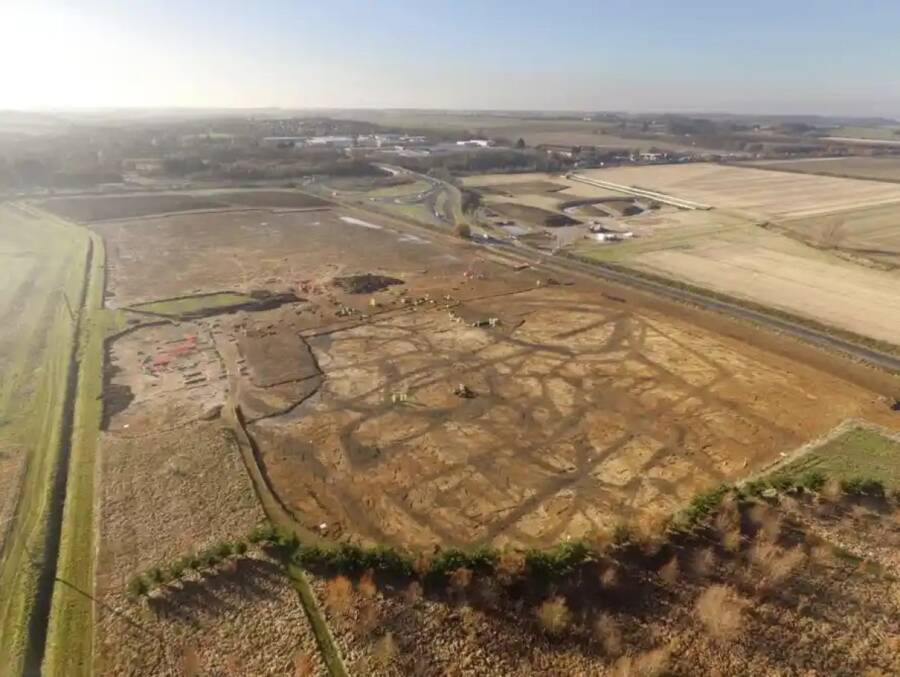The frogs may have been eaten by humans living at the site, or the amphibians may have suffered a "prehistoric frog tragedy."

Mike Kemp/In PIctures via Getty ImagesA common toad in England, possibly a descendant of the hundreds of Iron Age frogs found dead in Bar Hill.
Archaeologists dig up curious finds all the time. But a team from the Museum of London Archaeology (MOLA) made an especially peculiar discovery recently when they came across 8,000 frog bones in a ditch near an Iron Age roundhouse in Bar Hill, Cambridgeshire, England.
“In my experience, mainly working on sites from London, we don’t get that many frogs,” Vicki Ewens, MOLA’s senior archaeozoologist, told The Guardian. “To have so many bones coming from one ditch is extraordinary.”
To the Cambs Times Ewens added: “This is a puzzling and unexpected find, which we are still trying to fully understand.”
The bones, which the Cambs Times reports belong to about 350 individual frogs, were discovered during MOLA excavations as part of the National Highway A14 Cambridge to Huntingdon road improvement scheme. The bones seem to belong largely to common frogs and toads, as well as a more rare “pool frog.”
“We’ve also had possible evidence of pool frog, which is exciting,” Ewens told The Guardian. “It’s not something that we usually find archaeologically.”
Archaeologists came across the frog remains in a shallow ditch about 45 feet long, which seems to date to the late Iron Age (400 B.C.E. to 43 C.E.). But how did they get there? And why? Researchers have some theories.

MOLA/HeadlandInfrastructureThe archaeological site where the frog bones were discovered.
On Facebook, MOLA mused over several possible answers to this amphibian enigma. “Were the frogs eaten by the people living in the roundhouse?” they wrote. “Unlikely, but we can’t exclude it.”
According to The Guardian, the bones don’t seem to indicate that the frogs were consumed by humans, as they lack tell-tale signs like cut or burn marks. However, ancient people did sometimes eat frogs, and if they boiled them, it would be impossible to tell today. MOLA additionally noted that it didn’t appear that mammals or birds ate the frogs.
A second possibility is that frogs merely populated the site in droves because of a readily available food source.
“Were they drawn to this specific spot by the promise of food?” MOLA wrote on Facebook. “People living at the settlement were processing crops nearby. This might have attracted insects, which frogs are known to eat.”
Specifically, The Guardian reports that researchers found charred grains at the Iron Age site. This suggests that the people who lived there worked with crops, which likely attracted some of the frogs’ favorite things to eat: beetles and aphids.

MOLA/TwitterSome of the frog bones found at the Iron age site.
It’s also possible that disease killed off the frogs, much as it has in more recent times. “In the 1980s, UK frogs were heavily affected by a ranavirus,” the MOLA researchers said, according to the Cambs Times. “A similar disease might have had devastating effects on the amphibian population at Bar Hill.”
And, finally, MOLA mused that it’s possible that the frogs fell victim to an “ancient frog tragedy.”
“Some of these frogs might have fallen into the ditch of the roundhouse while migrating in spring,” MOLA wrote on Facebook, “or maybe they died while hibernating during winter.”
According to The Guardian, frogs move in large groups during their breeding season, during which they could have become trapped in the ditch. Alternatively, the frogs could have burrowed in mud to hibernate during the winter, then died after a particularly bad cold spell.
Then again, the frogs’ demise could be related to a mixture of all the reasons listed above. Ewens told the Cambs Times, “This accumulation of frog remains may have been caused by a number of different factors, possibly interacting over a long period of time.”
In addition to the frog bones, archaeologists also discovered some Iron Age pottery during their dig. These finds, and others unearthed by MOLA at the site between 2016 and 2018, are now being analyzed.
Perhaps further analysis will finally answer the question of what happened to 350 frogs thousands of years ago.
After reading about the frog bones found in an Iron Age ditch, learn about the fascinating and transparent glass frog. Or, see how archaeologists in England dug up an Iron Age chariot — with a horse attached.





